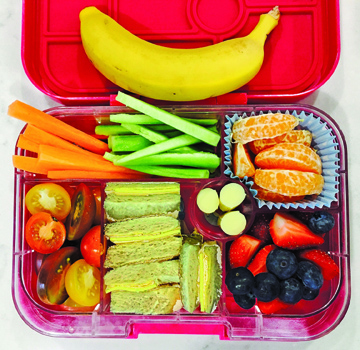by Liz Bravman, RN
The new school year is fast approaching. And with the new classes comes a whole new season of packing lunches and making sure kids are fueled for success. You may find yourself facing the same challenges year after year: How can you avoid packing the same items every day, while giving kids good nutritious choices. These tips can help.

1. Think in categories of needed nutrients. It’s common to get stuck on the go-to tradition of sandwiches. Instead, think “outside the loaf” and focus on packing one item from each of the four nutrient categories — Protein, whole grains, fruits and vegetables. (Note, fruits and vegetables are each their own category.)
These are examples:
Protein
• Eggs (hard boiled or scrambled to be put into a burrito)
• Nuts (almonds or cashews)
• Seeds (sunflower or chia)
• Nut butters (such as no sugar-added peanut butter or almond butter)
• Beans
• Dairy (cheese sticks, cream cheese or shredded cheese)
• Hummus
• Edamame
• Low-sugar Greek yogurt
• Rotisserie chicken meat
Whole Grains
• Whole wheat bread or small bagel
• Whole wheat crackers
• Whole wheat pretzels
• Brown rice
• Whole wheat pasta
• Rice cakes
• Corn or whole wheat tortillas
• Low-sugar whole grain cereal or granola
Fruits
• Apples
• Bananas
• Berries
• Clementine oranges
• Grapes
• Pineapple
• Frozen mango chunks
Vegetables
• Cucumber slices (try different seasonings on top)
• Carrot sticks
• Red pepper sticks
• Mini peppers
• Salsa
• Sugar snap peas
2. Tie it all together. Next, what does it look like when these four nutrient groups come together? Here are some lunch ideas that go beyond bread and sandwich meat:
• Whole wheat bagel with cream cheese and cucumber slices, and a handful of strawberries and cashews
• Celery with no sugar-added peanut butter with raisins on top (also known as “ants on a log”), apple slices, pretzels, and a cheese stick
• Low-sugar Greek yogurt, plain cheerios, banana, and a few mini peppers
• Hard-boiled eggs, rice cakes, cheese sticks, blueberries, and sugar snap peas
• Hummus with carrot sticks and cherry tomatoes, whole wheat crackers, and cheese stick
• Cold quesadilla with salsa and a small scoop of guacamole, cucumbers and frozen mango chunks
• Chicken noodle soup in a thermos, radishes, and a pear with a slice of cheese
• Whole wheat pasta, edamame, carrots and an apple
3. Remember the drink. Another area that can be tempting for kids is unhealthy drinks. Remember that juice boxes can have tons of added sugars. Water, seltzer or plain milk (or alternative dairy drink) are better options.
4. Get the kids involved. Research shows that when children help and are invested in their food choices, whether it is through shopping, gardening, prepping or cooking, they are more likely to eat healthy foods. When shopping, let them pick out a new and interesting fruit or vegetable to try in their lunch. Or start a garden at home, even if it’s just a container garden or window sill herb garden. You may be shocked at what your children will start loving.
5. Prepare for new choices. Finally, know that packing a nutritious meal every day can be a lot of work, but it can be just as challenging once your child outgrows sack lunches and has the ability to eat at school restaurants or go off-campus with friends. If this is common in your family, you can still help your child make good choices.
Empower your teen to look at online menus. Show them how many calories and fat grams certain items have. Explain what grams of sugar look like in real life — every 4 grams equal 1 teaspoon of sugar. A large fountain Coke has 80 grams of sugar, which equals 12 teaspoons of sugar. Let them know that the recommended quantity for kids under 18 is 6 teaspoons daily. This means that this one drink is double what their sugar intake should be for the entire day!
A former pediatric nurse, Liz Bravman, RN, is a cycling instructor, nutrition educator and personal trainer at the Susan M. Duncan Family YMCA in Arvada. She has a Bachelor of Science degree in nursing and a Master’s degree in nutrition education.
